Cat paws are as incredibly cute as they are useful.
From giving high-fives to walking to catching prey, your jaunty furball relies on her paws a lot.
Whether she has the standard number of toes on her paws or has slightly more than normal, she couldn’t do much without her precious paws.
Granted, she will still look beautiful but her life wouldn’t be the same.
In this guide, we will take a look at the comparison between a normal cat paw and a polydactyl paw. If you have a multi-toe cat, this information will come in handy.
1. Number Of Toes
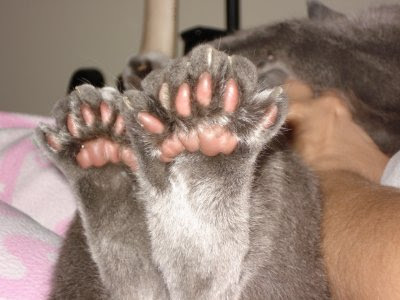
Many pet parents are blissfully unaware of how many toes their little kitties have.
Well, in all honesty, they are not to blame. No cat is ever willing to have her paws touched let alone take time counting them.
With the many nerve receptors in the paws, it is no wonder this part of the cat’s body is highly sensitive.
A normal cat has a total of 18 toes. Each of the front paws has five toes (four toe beans and one declaw) while the hind legs have four toes each (all are toe beans).
A polydactyl cat, on the otherhand, has extra toes. The terms “poly” and “daktylos” are Greek for “many” and “digits” respectively.
Polydactyl cats can have up to eight (or even more) toes on both front and hind paws.
A ginger cat by the name of Jake entered the Guinness Records as the cat with the highest number of toes.
The tabby kitty boasted 7 toes on each paw bringing the total to a whopping 28!
Most multi-toed cats have additional toes on their front paws, making your kitty appear as though she’s putting on mittens. This is why polydactyl cats are also called ‘mitten’ or ‘thumb’ cats.
The second comes from the placement of the toes on the front paws that makes the cat appear as though she has thumbs.
Like in normal cats, each toe in a polydactyl cat has a pad, claws, and bone structure.
2. Causes
Polydactylism in cats is a result of a hereditary genetic mutation passed down to the offspring by either parent.
The single, dominant autosomal gene overrides the normal genes in the paws leading to the addition of toes.
Ideally, if one parent of the cat has the polydactyl gene but the other doesn’t, 40-50% of the litter will develop the condition.
Ernest Hemmingway brought the world’s attention to the knowledge of polydactyl cats.
After being given a cute multi-toed cat by a Sea Captain in the 1930s, the writer fell in love with these special cats. He named his little gift Snow White.
The cat gave birth to more polydactyl cats some of which are preserved in the Hemmingway Home & Museum as historical treasurers.
Ernest’s love for cats with extra toes made the special felines bear the name “Hemmingway Cats”.
3. Functionality
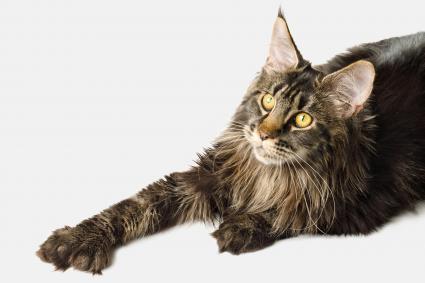
A normal cat uses her paws to perform several functions including locomotion, shock-absorption, grooming, climbing, killing prey, self-defense, and more.
They pretty much keep her alive. The back paws are designed to be stronger than the front to help the cat handle impact during jumping and running.
Each paw comes with a digital pad to cushion the foot. An extra-large pad at the center of each paw features three fatty lobes to absorb shock and act as support to the main leg.
A polydactyl cat has been known to be a better hunter because her extra toes give her an upper hand over the normal-pawed kitty.
She can use the extra toes to have a firm grip when walking and jumping, pick up toys better, climb up trees and walls like a human being, and navigate challenging ground such as snow or sand.
Cats with extra toes also have an easier time catching and grasping prey during the hunt.
Back in the day, sailors would bring polydactyl cats on board to help them hunt mice.
The additional toes gave them balance on the ship and an advantage when hunting.
4. Health Issues
Whether you have a cat with normal claws or one with extra toes, there is no guarantee she will be disease-free.
However, Hemmingway cats are at a higher risk of pain, discomfort, and infections. The extra claws can pose a danger to your feisty friend.
Under normal circumstances, the claws are naturally trimmed and filed when the cat scratches on the wall, a scratching post, or any other rough surface.
However, for a multi-toed cat, you have to physically trim the extra claws as they will keep growing longer.
Sometimes they get embedded into the toes causing pain and injury. If they grow around the toes, they can also emhance the movement of the feline.
Ripped, embedded, and ingrown toes is common with these special cats.
Sadly, these can cause infections like an abscess. The extra toes sometimes don’t grow as big as the normal ones.
They can be very tiny or deformed. Some even hang off the paw.
In some instances, the cat can rip the extra toe by accident if it catches a strong object as she runs or walks.
5. Care And Maintenance
As long as your cat has paws, you are required to groom her frequently.
The paws come in contact with all kinds of harmful substances. These range from harsh slaty snow to dry hot floors to sharp objects.
You need to wipe the paws, check for infection, moisturize, treat cracks and splinters, and trim the hair that sprouts between the toes.
For a Hemmingway cat, you need to do more than the average. As mentioned before, the extra claws never really wear down with average walking, running, and jumping.
If the claw catches a piece of the sofa, not only will it tear the thing apart but it can also injure your cat badly. This means you need to constantly check the claws regularly and clip them accordingly.
Since the extra claw can grow and get embedded in the footpad, you might want to have the claws removed to avoid infection and pain.
For cats with hanging toes, things can get really bad if the claws are not removed permanently.
Related Post: How to Declaw a Cat at Home
FAQs About Polydactyl Cats
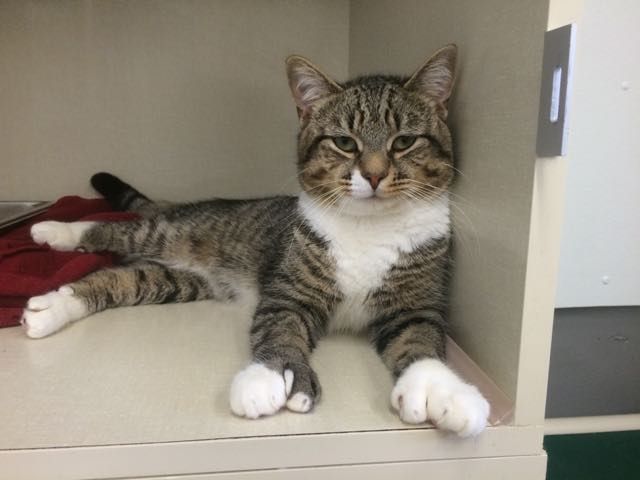
1. Do polydactyl cats have extra claws?
For sure. And sadly, some of the claws can grow where the declaw was supposed to be.
Others develop between the foot and the thumb and eventually get embedded in the pad.
Without proper care, these claws can cause pain and infection.
2. Are polydactyl cats healthy?
Yes. Polydactylism only affects the physique of the paw.
With the right care and maintenance, these cats enjoy a long, happy, and healthy life.
The problem arises if your kitty has ingrown, overgrown, and embedded claws and doesn’t get help to get them out of the way.
3. Are Polydactyl Cats Bigger?
Not really. The polydactyl gene only affects the number of toes the cat has.
It doesn’t affect the way she looks. Sure, Hemmingway cats have been known to have wider paws because of the extra toes but there’s no evidence that the gene has an effect on the size of the cat.
So, a normal and polydactyl cat from the same breed will look alike except for their toes.
4. Are Polydactyl Cats In Pain?
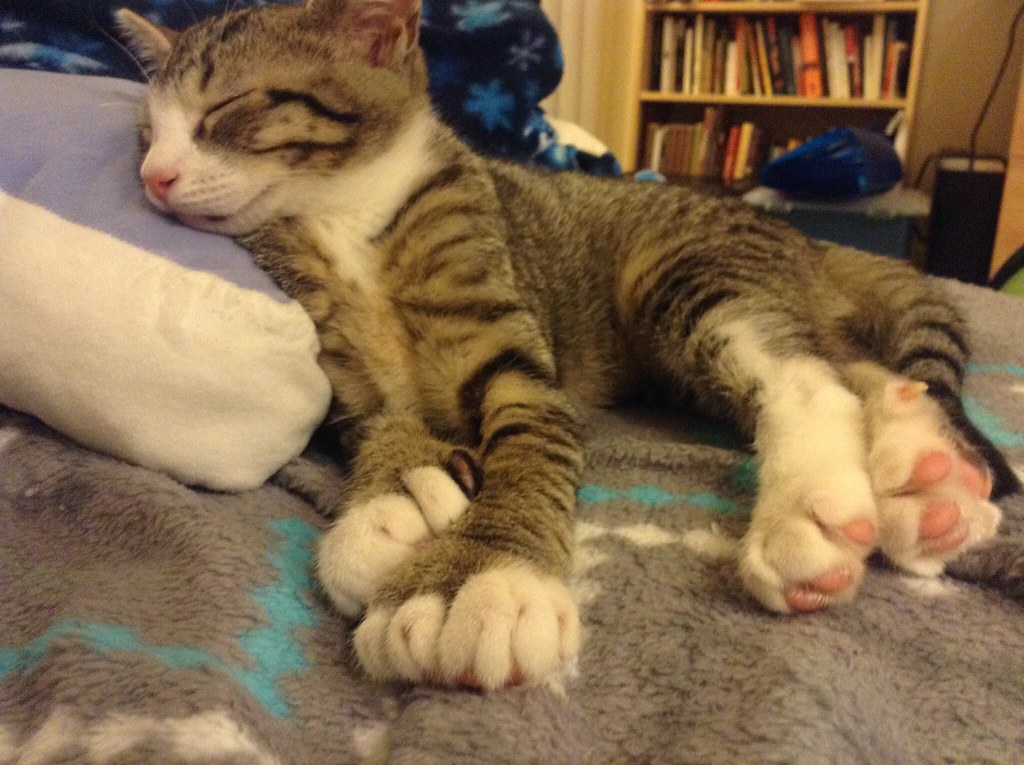
Not if they are groomed appropriately. Pain comes about if embedded and ingrown nails are not clipped regularly.
When they grow longer than they should, they can catch objects as the cat walks or jumps.
This can hurt the cat causing a lot of pain. Also, if the claws hang of the paw, they can cause problems for the cat down the line.
5. How Long Do Polydactyl Cats Live?
This depends on the breed among other factors.
Typically, there’s no difference between a cat with normal toes and that with extra toes as far as lifespan is concerned.
Most cats live to be 12-15 years, polydactyl or not.
6. What Percent Of Cats Are Polydactyl?
On average, 15% of felines in the world are polydactyl. In addition, a domestic cat has a 10% chance of getting the polydactyl gene.
7. What Breeds Of Cats Are Polydactyl?
In the past, the polydactyl gene was seen as a useful trait in the Mine Coon breed of cats.
Snowy Maine needed a cat with wider paws to act as natural shoes of sorts.
At some point, 40% of Maine Coons were Hemmingway Cats.
To date, the breed is still recognized for the trait but the number of cats with polydactylism has come down substantially.
Another breed associated with the trait is the American polydactyl.
8. How Do You Care For A Polydactyl Cat?
For the most part, look out for ingrown, overgrown, and embedded claws and clip them.
If you cannot afford to do this over and over again, plan on having the claws removed permanently by the vet.
You also need to clean the cat’s paws, trim hair between the toes, and moisturize the paws.
9. Are Polydactyl Cats Rare?
No. The polydactyl gene is actually very common than most people think.
Since it is an autosomal dominant trait, it is not related to gender.
As long as one parent has the gene, close to half of the litter will carry the gene as well.
Now imagine if both parents have the gene! Having said that, the likelihood that you will run into a cat with extra toes is rather low.
The parents may have the gene and not pass it down.
10. How Much Is A Polydactyl Cat Worth?
This is not your average cat so you bet she comes at a high price point.
A mittened kitten can set you back $1000 or more while an adult goes for $500 or less.
If you check adoption centers, you might be lucky to get one that will cost you considerably cheaper.
11. Are Polydactyl Cats Inbred?
We have a comprehensive answer here. Check it out. It’s an interesting read.
Related Post: Inbred Cats: Everything You Need to Know
12. Are Polydactyl Cats Smarter?
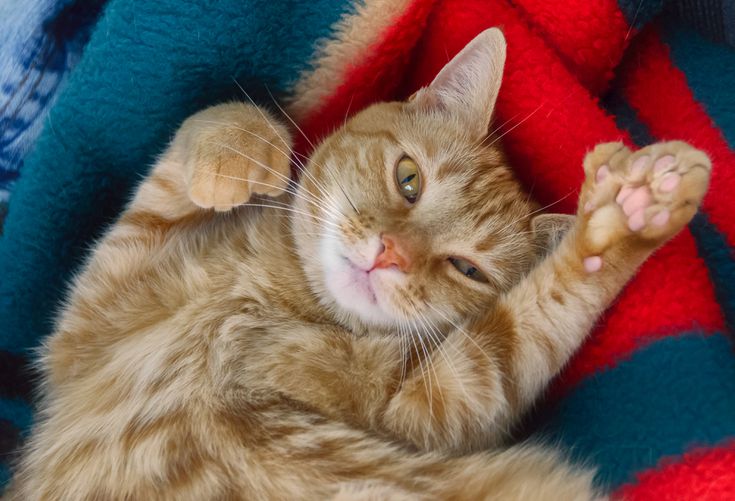
Cat parents with Hemmingway felines insist that their babies are intelligent.
However, there’s no scientific evidence to back this claim. These people may just be in love with their kitties and think they are smarter than the rest.
Maybe the fact that the extra toes help the cat do much more than the average cat makes these felines look smarter as well.
12. Can Polydactyl Cats Pick Things Up?
Some polydactyl cats behave as though they have human hands. This means they can pick up toys, climb like we do, among other things.
So yes, a polydactyl cat can pick things up.
13. Can Polydactyl Cats Open Doors?
Yes and no. The toes may help the kitty turn the doorknob but it may also not work like that.
13. Are Polydactyl Cats Clumsy?
Unless the cat has overgrown nails that affect functionality, polydactyl cats are as nimble as the rest.
14. What Are Opposable Thumbs In Cats?
This is a situation where the additional toes attach to the thumb or medial side of the paw giving the appearance of a cat with opposable thumbs.
Cats with this type of paws use their thumbs pretty much as we, humans, do.
Parting Thoughts
Many people are afraid of owning polydactyl cats because they have no idea what that means for them.
Hopefully, this guide has shed enough light to make you realize that mitten cats are equal to normal-paws cats in so many ways.
Related Posts:
Common Cat Toe Beans FAQs Answered
Cat Breeds with Tufts of Fur between Toes
12 Awesome Cats with Long Legs
18 Cat Claws Anatomy Facts for Beginners

Hi! I am Eleanor Price. I started this website after my cat, Louie, almost died from a case of botulism (a type of food poisoning often caused by bacteria that grow on food items). Turned out that my cat’s diet was the problem. I have made it my duty to provide the best information and recommendations about everything cat lovers need to know about their felines’ health and wellbeing. My goal is to find the most informative content on anything feline-related and share it with fellow hardworking kitty lovers.

